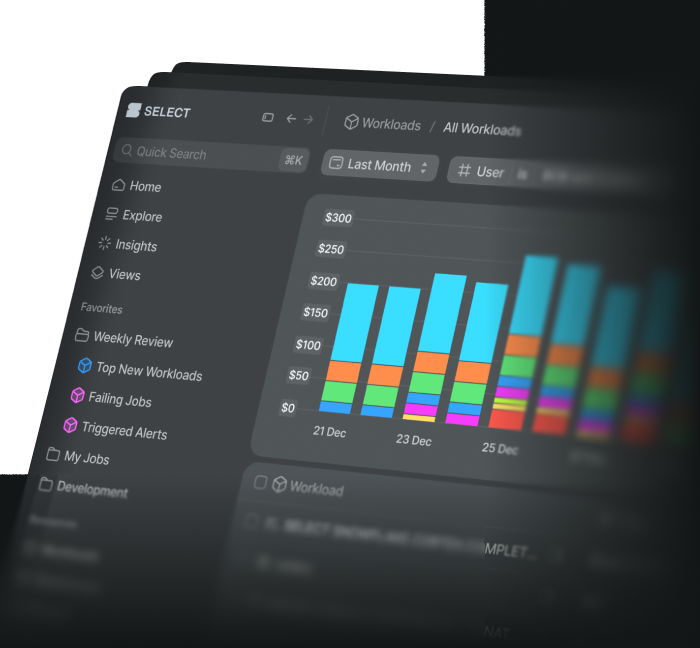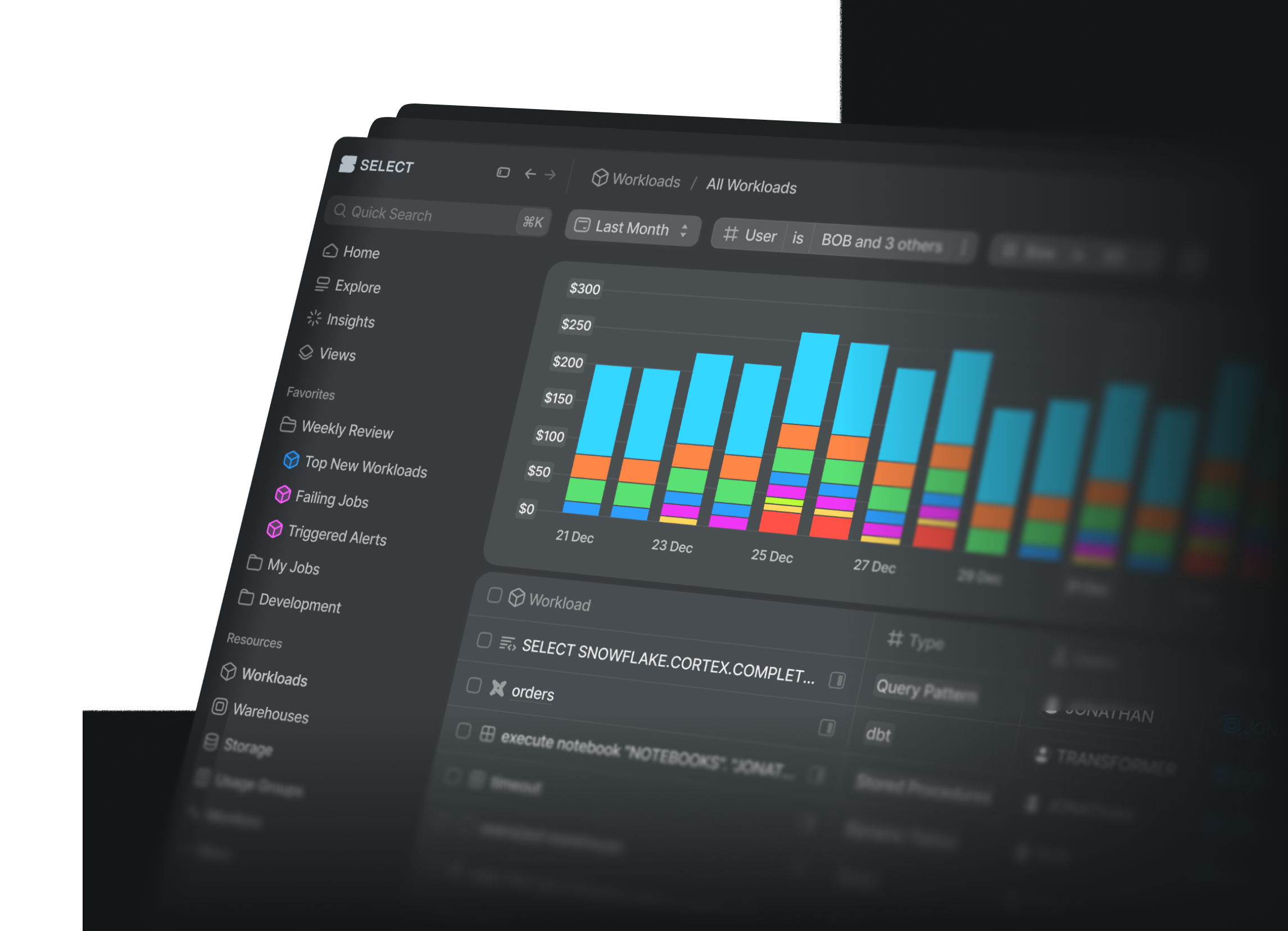
How Kargo identified a $500K/year savings opportunity and delivered 5X ROI with SELECT

Kargo is a video hosting, sharing, and services platform known for its high-quality playback and creative community. Founded in 2004, it caters primarily to filmmakers, artists, and businesses seeking professional video tools.
Advertising Technology
1,200+
New York City, United States
2003
Challenges
Kargo has used Snowflake for 8 years as their central platform for processing raw microservice logs, transformations, and analytics. Leadership pressure to consolidate warehouses for efficiency eliminated cost visibility, leaving teams unable to answer basic questions about processing costs. Snowflake RSA-provided dashboards were rudimentary and couldn't provide the granular insights needed for optimization decisions.
Solution
SELECT provided immediate cost visibility through comprehensive query tagging down to the Airflow task level, enabling precise cost attribution across their consolidated warehouse infrastructure. The platform's intuitive interface eliminated friction from cost analysis, while usage groups enabled aggregate cost monitoring for leadership reporting. SELECT's before-and-after visibility supported systematic refactoring efforts across their data pipelines.
Results
- Achieved immediate 5X ROI through 30% Looker warehousing cost reduction via Automated Savings
- Identified $500K/year single event processing cost, enabling strategic architecture shift to Spark
- Empowered data engineering team with self-service cost insights for optimization tracking
- Enabled accurate cost forecasting and budget tracking through organization-level visibility
- Supported systematic refactoring with before-and-after cost comparison capabilities
Eight years of Snowflake adoption created cost visibility challenges
Kargo has been using Snowflake since its inception, making them one of the platform's earliest adopters. Their architecture centers on processing massive volumes of raw JSON logs from microservices that handle their supply-side platform operations.
The platform processes auction data and outcome data (impressions, clicks, etc.) across web and CTV advertising channels. All raw data flows into Snowflake for JSON parsing, transformations, and aggregation before serving analytics through Looker.
As a mature Snowflake user, Kargo initially managed costs through warehouse separation - different microservice logs processed in dedicated warehouses to enable cost breakdowns. However, this approach proved inefficient for resource utilization.
“We had to split out warehouses to see the cost breakouts. We couldn't see cost by event type or pipeline, only by high-level microservice.”
Diana Koshy
Sr. Director of Data Engineering at Kargo
Leadership pressure eliminated cost visibility through warehouse consolidation
When Diana joined three years ago, leadership was concerned about Snowflake costs and worked with Snowflake RSAs to optimize their setup. The recommendation was warehouse consolidation to improve resource utilization.
“Leadership was saying it was too expensive. Got an RSA involved. Consolidated warehouses. But then that led to less visibility on the cost visibility.”
Diana Koshy
Sr. Director of Data Engineering at Kargo
While consolidation improved efficiency by maximizing usage of already-running warehouses, it eliminated the ability to see cost breakdowns. Teams moved from microservice-level visibility to a single lump sum with no granular insights.
The Snowflake RSAs provided basic dashboards, but these were inadequate for the level of analysis needed to optimize their complex, high-volume processing pipelines.
Teams couldn't answer fundamental cost questions
The lack of granular cost visibility created constant frustration when stakeholders asked basic questions about processing costs. Everyone kept asking. We had no freaking idea. Said Diana while describing the situation before SELECT.
Leadership frequently asked questions like "How much does it cost to process targeting?" or "What's the cost per event?" Without proper attribution, these questions required manual analysis that was time-consuming and often inconclusive.
The team recognized they needed a solution that could provide the granular insights they'd lost through warehouse consolidation while maintaining the efficiency gains from their optimized infrastructure.
SELECT delivered immediate 5X ROI through automated savings
SELECT's Automated Savings feature provided instant value, reducing Kargo's Looker warehousing costs by 30% with zero effort required from the team, and giving Kargo an immediate 5X ROI on SELECT.
This immediate cost reduction not only paid for SELECT but demonstrated the platform's value in identifying optimization opportunities that weren't visible through traditional monitoring approaches.
SELECT granular cost visibility revealed $500K/year single event opportunity
The Kargo team implemented comprehensive query tagging across their pipelines, tagging down to individual Airflow tasks to enable precise cost attribution across their consolidated warehouse infrastructure.
“We started putting query tags on a per event, per pipeline basis so that we could easily see what are the most expensive ones in SELECT”
Diana Koshy
Sr. Director of Data Engineering at Kargo
This granular tagging immediately revealed their most costly processing pipeline: bid request events, which were costing $500,000 annually - far more than anticipated.
“That was the thing that we're like, oh, this is costing us $500,000 a year for just this one event.”
Diana Koshy
Sr. Director of Data Engineering at Kargo
This insight enabled a strategic architecture decision to move their most expensive workload from Snowflake to Spark processing, fundamentally changing how they approached their most costly operations.
Intuitive interface eliminated friction from cost analysis
SELECT's user experience proved transformative for how the team approached cost optimization, eliminating the barriers that had made cost analysis difficult in the past.
“You guys have the best UI experience that I've had of any software. It's like you just read my mind where, like, oh, I wish I could click there. Oh, I can”
Diana Koshy
Sr. Director of Data Engineering at Kargo
The platform's intuitive design enabled natural exploration and analysis, allowing team members to drill down from warehouse-level costs to specific workloads without complex queries or manual data manipulation.
“Everything that I've seen is literally exactly how my brain thinks about stuff and how I'd want to dive deeper”
Diana Koshy
Sr. Director of Data Engineering at Kargo
Usage groups enabled aggregate cost monitoring for leadership
SELECT's usage groups feature solved a critical reporting challenge by enabling cost aggregation across multiple pipelines and warehouses for high-level business reporting.
“Leadership comes up to me and says, how much is this whole targeting thing costing? I can answer that instantly now through SELECT's cost allocation reporting.”
Diana Koshy
Sr. Director of Data Engineering at Kargo
Usage groups allowed the team to group related workloads and provide accurate aggregate costs to leadership, even when those workloads spanned multiple warehouses and processing pipelines.
Before-and-after visibility supported systematic refactoring
As the team undertook systematic refactoring of their data pipelines, SELECT provided crucial before-and-after visibility that enabled them to measure optimization success.
“We were using this even as we were doing refactoring, because as we were doing refactor, we wanted to see before and after, and you guys can clearly show us historical cost trends.”
Diana Koshy
Sr. Director of Data Engineering at Kargo
This capability was essential for validating that optimization efforts were successful and quantifying the impact of specific changes.
“Engineers can now confidently monitor and understand the tweaks they've made, and be confident that they had the desired impact on costs and performance.”
Diana Koshy
Sr. Director of Data Engineering at Kargo
Team empowerment through self-service cost insights
SELECT enabled democratization of cost insights across the data engineering team, allowing individual engineers to track the impact of their optimization efforts independently.
“We gave access to everybody on my team who's a data engineer, basically. And as they're making these optimizations, they can go and see what the effect is on their pipelines.”
Diana Koshy
Sr. Director of Data Engineering at Kargo
This self-service capability transformed how the team approached optimization work, making cost impact visible and measurable for individual contributors rather than requiring centralized analysis.
Looking ahead: Expanding beyond Snowflake
As Kargo continues moving expensive workloads to Spark and other technologies, they're eager for SELECT to expand beyond Snowflake to provide similar visibility across their entire data infrastructure.
“I wish I had SELECT for all infrastructure costs that I'm tracking!”
Diana Koshy
Sr. Director of Data Engineering at Kargo
The success they've achieved with Snowflake cost optimization has created demand for similar capabilities across their AWS, Kubernetes, and Spark environments as their architecture continues evolving to optimize for both cost and performance.


Up next.More Customer Stories.
Get up and running in less than 15 minutes
Connect your Snowflake account and instantly understand your savings potential.




